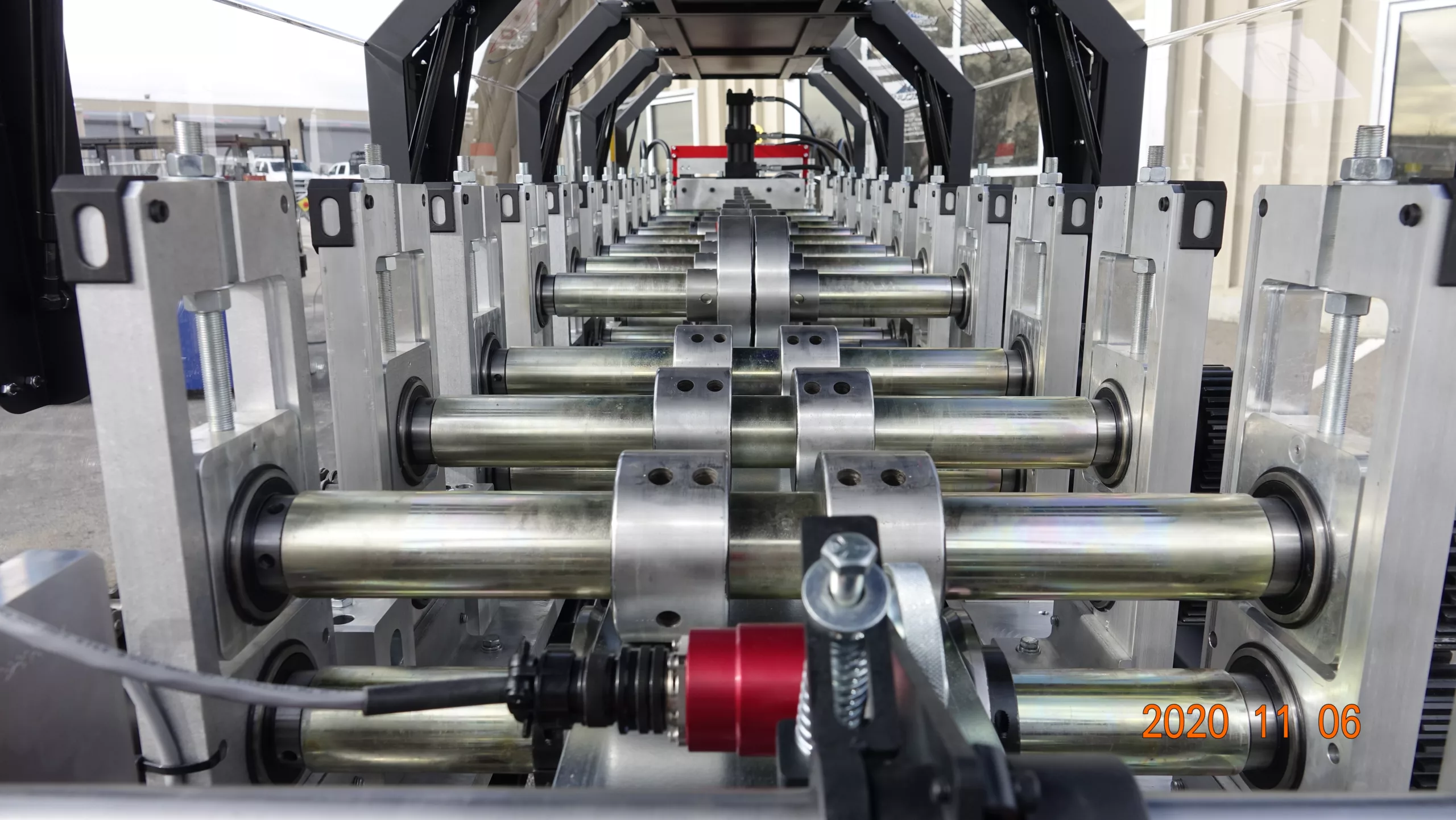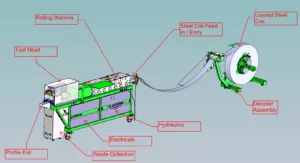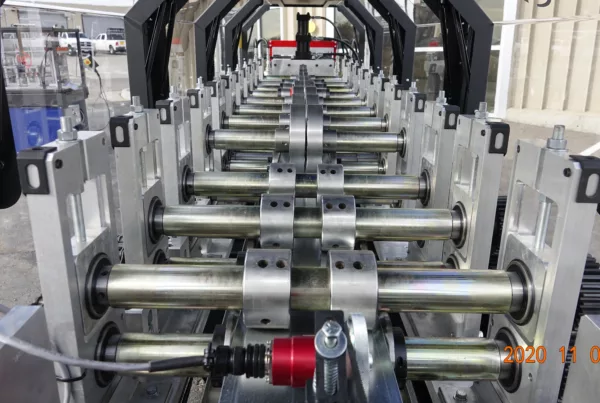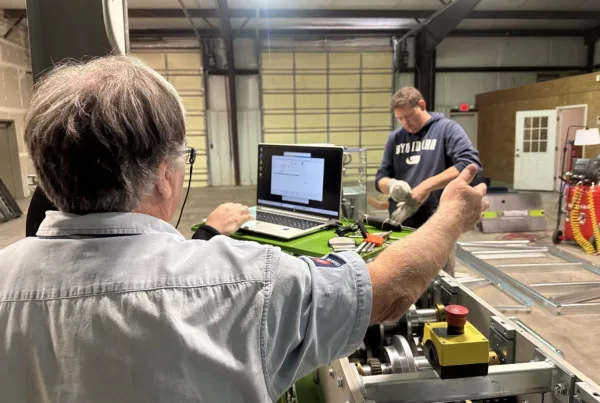A well-maintained roll former is the backbone of any successful cold-formed steel framing fabrication operation. Whether producing steel framing components for residential, commercial, or modular construction, the performance of the roll forming machine directly impacts efficiency, quality, and uptime. While roll forming technology has come a long way in terms of automation and precision, the key to sustaining long-term productivity lies in the routine maintenance of every major system in the roll former assembly. In this article, we’ll walk through the core components of a roll former machine and share actionable advice on how to keep each element running smoothly throughout the roll forming process.
Breaking Down Sections of a Roll Forming Machine
The rolling process is the foundation of roll forming, which is a continuous process used to create long metal shapes with specific cross-sectional profiles. This process involves the gradual deformation of metal sheets or strips through a series of precisely engineered rollers. Unlike press braking or stamping, this method allows for smooth, continuous forming with minimal stress on the material. A roll forming system includes several key components that contribute to this efficiency:
- Decoiler: Feeds metal coil into the system while minimizing stress and misalignment.
- Rolling Stations: Precisely spaced rollers gradually form the desired shape with consistent force and alignment.
- Hydraulics: Power essential for forming and punching operations throughout the machine.
- Electricals: Regulate timing, motor speeds, and process synchronization.
- Tool Head: Houses the custom die sets, punches, or shear systems needed for each project.
- Software: Converts files into machine instructions for automated production.
Each section of a roll former has unique maintenance needs. Here we outline best practices for maintaining each key component of a roll forming machine to ensure optimal performance and reduce downtime.
Maintaining the Decoiler – First Step in Roll Forming Process
Let’s start where the roll forming process begins, with the decoiler. This is the first critical stage in feeding material into the roll forming machine. In many setups, such as Scottsdale’s automated roll forming systems, the decoiler handles heavy coils of cold-formed steel, sometimes weighing up to 1,500 kg. Maintaining this component is essential not only for productivity but for workplace safety as well.
- Check Bolt Tension – One of the most common yet overlooked issues is improper bolt tension on the decoiler carriage. These bolts need just enough play to allow the scissor action to operate correctly; if overtightened, the movement becomes restricted, potentially leading to misalignment or system strain.
- Inspect Coil Plates – Coil plates should also be inspected regularly for cracks, especially at the welds, as a failure here could cause a coil to collapse or drop, posing a significant safety hazard.
- Maintain Braking System – Another key consideration with the decoiler is the braking system. Consistent tension ensures smooth material feed, and if the brake is not adjusted properly, it could result in jerky coil movement or slack material, which causes delays and quality issues downstream.
- Control Drive Roll Pressure – The driving pressure should also be monitored closely. It’s easy to assume that more pressure equals better feed, but that’s not the case. Applying too much pressure risks overloading the motor and can result in tripped circuits or blown fuses in the electrical cabinet.
- Optimize Actuator Arm Adjustment – Actuator arms should be adjusted using the cam at the microswitch to reduce the number of times the motor cycles on and off. Fewer cycles lead to longer motor life and more consistent performance.
- Safely Operating the Jack – For roll forming setups that include a jack on the decoiler, using the safety pin to relieve the jack’s load when the coil is stationary can significantly extend the lifespan of the jack seals and reduce wear.
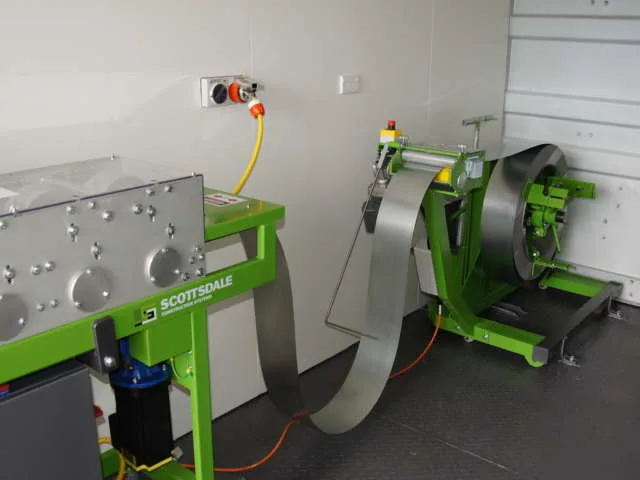
Watch the video of a 6,500-lbs powered decoiler in operation with KFS Framemaker 1420 G1 roll forming machine.
Aligning the Infeed Guides for Accurate Cold-Formed Steel Profiles
Once material enters the roll forming machine, the infeed guides take over. This stage may seem straightforward, but it plays a vital role in product accuracy. The purpose of the infeed system is to center the steel strip before it enters the forming rolls. Even a slight misalignment here can throw off lip lengths and introduce unwanted twists into the finished steel framing member. It’s important to ensure the locking lugs on the infeed guides are always secure. If these loosen during operation, the guides can drift, compromising cold-formed steel profile consistency and causing rework or scrap.
Rolling Stations Maintenance for Precision Steel Framing
At the heart of the roll forming process is the rollcage. This is where the steel is gradually shaped into its final profile through a series of precisely calibrated roller dies. Depending on the specific roll former machine, gauge adjustments may be automatic or manually preset. The rolls must be set according to the exact gauge of the material being processed. If the roll gaps are too tight, the machine works harder than necessary, leading to premature wear and excessive bowing of the profile. On the other hand, if the rolls are too loose, the risk is incomplete forming, poor tolerances, and possible jamming.
Chain tension is equally critical in this area. The rollcage distributes load across multiple stations, and uneven chain tension can lead to irregular movement, putting stress on sprockets and causing uneven wear. Chain tensioner blocks make it relatively simple to fine-tune the balance and help extend the life of the roll former.
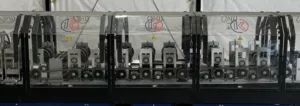
Servicing the Tool Head in Your Roll Former Machine
One of the most complex areas of a roll forming machine is the tool head, which houses the hydraulic system responsible for the cutting and punching operations. Hydraulics power the movement of blades, punches, and shear mechanisms, and any failure here can halt the entire production process. The tool head is controlled by solenoid valves, and its proper function depends on keeping seals intact and hydraulic oil free from contamination. Leaks are a common issue. While some leaks, such as those from the cutting head, can be visually identified by oil drops, others, like leaking cap seals, require more diagnostic insight.
If the pressure gauge drops and recharges while the machine is idle, there may be a leaking cap seal. One way to identify the affected area is by touching. The sections of the tool head that feel hotter than the surrounding areas usually indicate active leaks under pressure. These temperature differences are caused by hydraulic oil being forced through compromised seals. Prompt seal replacement prevents fluid loss, reduces strain on the pump, and avoids more costly failures.
The cutting faces themselves are also a point of maintenance. Blunt cutting tools require more hydraulic force to operate, increasing wear on the entire system. Dull blades also result in rough cuts, burrs, and potential injuries during handling. Blade lifespan will vary depending on the gauge and tensile strength of the material being formed, so it’s important to inspect them regularly and replace or sharpen as needed to maintain clean cuts and system efficiency.
Protecting the Hydraulic System for Long-Term Roll Forming Performance
The hydraulic system deserves close attention. It operates in a closed-loop configuration with built-in filtration, but hydraulic oil still degrades over time. Dirty or low-viscosity oil can damage pumps and motors, reduce response times, and cause overheating. Oil should be changed at least annually and even more frequently in high-volume operations. It is recommended to use 46-grade hydraulic oil to maintain viscosity under load.
Another vital component is the accumulator, which should be charged to 110 bars of nitrogen. This pressure setting helps buffer the system and reduces the cycling load on the hydraulic pump. The accumulator function can be checked by monitoring the pressure gauge during machine shutdown. If the pressure drops and stabilizes near 110 bars before falling to zero, the accumulator is doing its job correctly.
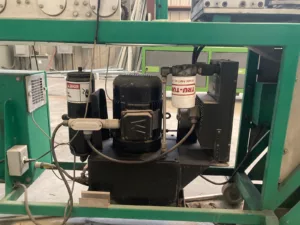
Caring for the Electrical Cabinet in Roll Forming Machines
Moving into the electrical system, the electrical cabinet is one of the most sensitive parts of any roll former machine. It houses both low-voltage communication systems and high-voltage equipment for powering the entire roll forming line. Keeping this area in good condition is vital for machine reliability and operator safety.
- Check Plugs and Connections – Periodic checks should be made to ensure all plugs and cable connections are tight and secure. Loose connections can introduce random system faults, which are often difficult to diagnose.
- Inspect Fuses – The machine’s fuses, typically 5A slow-blow types, have indicator lights to signal when they’ve blown. These should be checked regularly and replaced as necessary.
- Cooling Fans and Filters – The cooling system within the cabinet is equally important. Dust and debris can clog filters and reduce fan performance, leading to overheating and shutdowns of the roll former. Cleaning filters and confirming that fans are operating correctly is a simple but essential step in maintaining electrical stability.
- Safety First – Note that any internal work in the cabinet should only be performed by licensed electricians, and only when the machine is turned off and isolated from power.
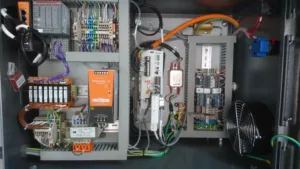
Managing the Digital Command Center of the Roll Former
Finally, we come to the laptop, the digital command center of the roll forming machine. The laptop manages machine control software, file processing, and synchronization between hardware components. The laptop must be used exclusively for machine operation. Installing unrelated software or storing excess files can lead to system lag, poor communication with the roll former, or even operational errors. Regularly cleaning out unnecessary files, defragmenting storage, and performing software updates will help maintain performance. In addition, refreshing the machine’s database file, commonly the .FDB file in systems like Scottsdale Construction Systems’, helps ensure smooth communication between the roll former machine and the control interface.
Keeping Your Roll Former in Top Condition
Maintaining the roll forming machine is not just about following a checklist but about understanding how each system contributes to the overall roll forming process. From decoiler to tool head, from hydraulic circuits to the control laptop, every element plays a vital role in delivering high-quality steel framing members. By dedicating time to preventive maintenance and keeping every component clean, aligned, and properly adjusted, operators can maximize the life of their roll former machine, reduce costly downtime, and deliver precision-engineered cold-formed steel framing products every time.
Additional Scottsdale Roll Forming Solutions and Resources
- Blog – Roll Forming Process: A Complete Guide to Metal Forming
- Blog – Empowering New Steel Framing Businesses: From Startup to Success
- Blog – Expert Tips for Successfully Operating a Roll Forming Business
- Blog – Best Advice from Steel Framing Shops to Implement Today
- Video – Why Tag Frames Trusts Scottsdale in Roll Forming Technology
- Downloads – Decoiler Information
- Financial Services
To learn more about Scottsdale’s roll forming solutions, visit us at www.scottsdalesteelframes.com, call at +1 (888) 406-2080, or email at rollformers@scottsdalesteelframes.info.
